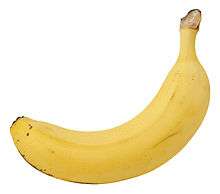Pisang goreng
|
Frying banana in Rantepao, Indonesia | |
| Type | Snack |
|---|---|
| Place of origin | Indonesia[1] |
| Region or state | Southeast Asia |
| Main ingredients | Banana, batter |
Pisang goreng (fried banana in Indonesian/Malay)[2][3] is a snack food made of banana or plantain, covered in batter or not, being deep fried in hot cooking oil, mostly found throughout Indonesia,[1] Malaysia, Cambodia, Thailand,[4] Singapore,[5] Brunei and the Philippines.
It is consumed as a snack in the morning and afternoon.[6] In Indonesia and Malaysia, pisang goreng is often sold by street vendors,[7][8] although some sellers have a storefront from which to sell their wares.
Ingredients
Plantain is often used instead of banana. Traditionally, some type of banana such as pisang raja and pisang tanduk are the popular kind of banana used for pisang goreng. The banana is often battered and then deep fried in ample of palm oil. Pisang goreng might be battered or plainly deep fried. The batter most commonly uses the combination of flour, either wheat, rice flour, tapioca or bread crumb. Several recipe might add coconut milk or milk and vanilla extract into the batter to add aroma.[9]
Most of traditional street vendors will then sell them as it is, without any additional ingredients or toppings. However, fancy coffee shops, cafe and restaurants that serve pisang goreng are more sophisticated and present them in various ways; such as sprinkled with powdered sugar, cinnamon sugar, cheese, jam, condensed milk, chocolate or vanilla ice cream.[1]
Pisang goreng in Indonesia
In Indonesia, pisang goreng is consumed as a snack to accompany tea or coffee,[10] either in the morning or late afternoon break. Traditional warung kopi (local humble coffee shop) often offer pisang goreng and other snacks, including fritters and kue to accompany coffee or tea.
In Indonesia, pisang goreng come under the category of gorengan (Indonesian: fritters, from goreng "to fry"), and many varieties are sold on travelling carts or by street vendors throughout Indonesia.[7] Other than pisang goreng, various kinds of ingredients are battered and deep fried such as tempeh, mendoan, tahu goreng (fried tofu), oncom, sweet potato, cassava chunk, cassava tapai, cireng (tapioca fritters), bakwan (flour with chopped vegetables) and breadfruit.[11]
Every regions in Indonesia has developed various recipe for pisang goreng with a variety of different names, ingredients and cooking technique. In Bali for example, pisang goreng is called godoh biu, in West Java it is called cau goreng, in Java gedhang goreng, in Sibolga pisang rakit and in Pontianak pisang kipas.[12]
Pisang goreng kipas refer to banana cut in the shape of fan, battered and deep fried. Pisang goreng usually sold together with other gorengan fritters including fried tofu and tempeh. However, Pisang goreng Pontianak are widely popular in Indonesia and exclusively sold in certain retail outlet.[1] The term pisang goreng Pontianak often used interchangeably with pisang goreng kipas, as both has similar fan-like shape, but often filled or served with Kaya jam.[13]
Pisang goreng pasir literally means "sandy fried banana", refer to banana coated in bread crumbs resulting in grainy crispy crumbs that its skin has similar texture with croquette. Javanese pisang goreng kremes employed slightly different technique of battering and frying. The coating batter is made from rice flour, vanilla essence and coconut milk, resulting is sweet fragrant aroma.[13]
Similar or related dishes
In the Philippines, it is called by different names as it has different variations. It is called "maruya" if coated in batter prior to frying, pritong saging for those that are simply fried in oil, or "banana cue or "toron" for those that are fried in oil and sugar before sticking into wooden skewers. These are often served as mid-afternoon snacks.
In Suriname this snack is also known as bakabana (meaning baked banana in Surinamese).[14]
Gallery
- Banana Fritter
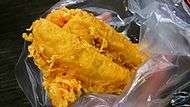 Pisang goreng.
Pisang goreng.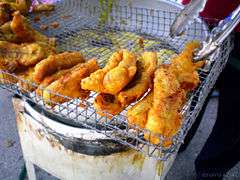 Indonesian roadside gorengan (fritter) peddler offering pisang goreng.
Indonesian roadside gorengan (fritter) peddler offering pisang goreng.- Pisang goreng with paler batter.
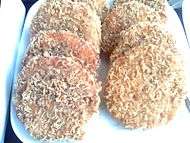 Disc-shaped flat pisang goreng.
Disc-shaped flat pisang goreng.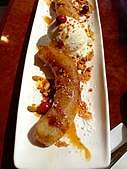 Pisang Goreng with vanilla ice cream
Pisang Goreng with vanilla ice cream
See also
- Chuối chiên, Vietnamese version of fried bananas
- Fried plantain, African version of fried bananas
- List of banana dishes
- Pazham pori
References
- 1 2 3 4 Rishi, Inderjeet (2012). Super Snacks: 100 Favorite Snacks from Five Continents. Trafford Publishing. ISBN 9781466963559.
- ↑ Davidsen, Katherine (2013-02-12). Tuttle Compact Indonesian Dictionary: Indonesian-English English-Indonesian. Tuttle Publishing. ISBN 9781462910816.
- ↑ Backshall, Stephen (2003). Indonesia. Rough Guides. ISBN 9781858289915.
- ↑ "Google search: over 78,000 results". Retrieved 2 September 2016.
- ↑ Tay, Leslie. "Million Stars Goreng Pisang". ieatishootipost.sg.
- ↑ Visit Sabah, Malaysia Borneo Archived October 17, 2009, at the Wayback Machine.
- 1 2 Kraig, Bruce; Sen, Colleen Taylor (2013-09-09). Street Food Around the World: An Encyclopedia of Food and Culture. ABC-CLIO. ISBN 9781598849554.
- ↑ "GORENG PISANG: A STREET HAWKER DELIGHT IN PENANG, MALAYSIA Travel Blissful". travelblissful.com.
- ↑ "Pisang Goreng (Indonesian Banana Fritters)". allrecipes.asia. Retrieved 2018-06-25.
- ↑ "Pisang Goreng (Indonesian Banana Fritters) with coffee or tea before the class begins - Picture of Lobong Culinary Experience, Ubud - TripAdvisor". www.tripadvisor.co.uk. Retrieved 2018-06-25.
- ↑ Fauziah (2017-06-02). "Gorengan: Indonesia's Favorite Fried Snacks - Indoindians". Indoindians. Retrieved 2018-06-27.
- ↑ "Resep Pisang Goreng - InfoReseps.com". inforesep.com. Archived from the original on 2013-05-30.
- 1 2 Fauziah (2017-07-07). "All about Pisang Goreng". Indoindians. Retrieved 2018-06-25.
- ↑ South American Food
External links
| Wikimedia Commons has media related to Pisang goreng. |
